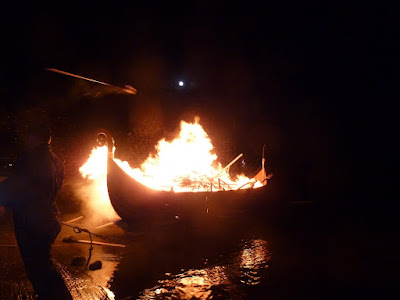 |
| Gael Charn: the approach |
Wednesday, 23 March 2011
Ascent: 640 metres,
Distance: 13 kilometres,
Time: 3 hours 49 minutes
m Gael Charn (Laggan) 926m 2hrs 12mins
m Gael Charn (Laggan) 926m 2hrs 12mins
Travelling back by plane from Shetland to Inverness this morning, I had a yearning to get another Munro in the bag. The day was not encouraging with claggy conditions and the cloud down to about 500 metres. However, any excuse to get off the A9 is to be seized so I turned off at Kingussie to avoid the road works ahead and took the road to Newtonmore and then Laggan. Gael Charn is the most westerly of the 4 munros in the Monadhliath Mountains the vast stretch of unexceptional high land to the northwest of Newtonmore. I had combined the 4 Munros on two occasions, once from east to west as a long hill run in summer and once from west to east in December in deep snow. We finished at 7pm, long after dark, and my two friends regarded this as one of the dafter expeditions that I had dragged them along on.
I had also climbed Gael Charn twice as a singleton and that was the plan today. I drove to Garva Bridge, one of the most remote places in Scotland and the source of the River Spey. It was 11:30am before I started walking, light rain and low clouds meant there was little to see on much of the ascent. I crossed the river to the track and then crossed back again and followed an old path which kept to the right bank of the Allt Coire nan Dearcag.
I had also climbed Gael Charn twice as a singleton and that was the plan today. I drove to Garva Bridge, one of the most remote places in Scotland and the source of the River Spey. It was 11:30am before I started walking, light rain and low clouds meant there was little to see on much of the ascent. I crossed the river to the track and then crossed back again and followed an old path which kept to the right bank of the Allt Coire nan Dearcag.
About halfway up I met a young Cornishman descending and we had a long chat. He worked for IBM in Portsmouth but he had moved to Doune near Stirling mainly so that he could climb the Munros. He had a weekly commute to Southampton but seemed to think it was a worthwhile trade-off. He had all the enthusiasm of someone newly converted and had managed 86 Munros in a year and a half with most of the best ones yet to do. I was a bit envious of the new adventures in store for him but delighted that he was getting so much enjoyment out of walking the Munros.
The ground was waterlogged apart from the fingers of wet snow that extended down the hill and became predominant above 600 metres. The burns were swollen so I had to head towards Beinn Sgiath before I found a place to cross the burn and make the last 250 metres of ascent. It seemed a long way to the summit cairn but I was encouraged by the sound and then the sight of three ptarmigan and, unusually, I got close enough to photograph them before they flew off.
A drink was all I had with me but I spent ten minutes at the summit listening to the ptarmigan in the vicinity. It was still cloudy and I had to take a bearing at the start of the descent, I saw another four ptarmigan and a couple of mountain hares in their white winter coats. The cloud eventually lifted and the route down became obvious. The day was still improving, I made good speed and enjoyed the views over to the Creag Meaghaidh range of hills and managed to get some photographs on the descent.
The pylons march across the upper Spey Valley from the Corrieyairack Pass but are lost in the grandeur of the highland landscape. Larger pylons are to be erected as part of the Beauly to Denny powerline upgrade but there will be fewer of them and I doubt that they will be any more detrimental to the landscape. This is a remote and unfrequented country and not one of the most sensitive parts of the route, although some would dispute this. The walk had been a pleasant interlude which I had not anticipated at the start of the day but 'go with the flow' adventures are usually the best way to travel.
I was changed and driving away by 3:25pm. It is a long way back to Laggan but then the A889 to Dalwhinnie is much preferable to the A9. I was home by 5:30pm and fully appraised of Chancellor Osborne's budget, which seemed pretty much a 'there she blows' holler. I doubt that it will do anything to ameliorate the damage that is currently taking place to the economy or the cost of living.
 |
| Gael Charn Summit |
 |
| Garva Bridge - the source of the River Spey |
 |
| River Spey from Garva Bridge |
 |
| Ptarmigan near the summit of Gael Charn |


























